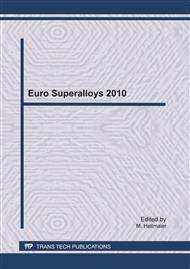p.295
p.301
p.306
p.312
p.321
p.327
p.333
p.339
p.345
The Relaxation Behavior of High Chromium- Ni Base Superalloys
Abstract:
The relaxation behavior of wrought high chromium Ni-base alloys Nimonic 80A, Nimonic 101 and Nimonic 105 was studied at different temperatures. All of these alloys exhibited increase in the residual stress during the relaxation tests e.g. at 450°C for Nimonic 80A and 650°C for Nimonic 105. The observed increase in the residual stress is a manifestation of the known phenomenon of “negative creep”. The stress free aging of specimens of these alloys exhibited dimensional contraction at different temperatures ranging from 450°C to 650°C. The abnormal relaxation behavior of these alloys and the observed contraction were attributed to the precipitation and ordering of the intermetallic phase Ni2(Cr,Mo) at the test temperature. The differential thermal analysis i.e. DTA results, demonstrated endothermic peaks to correspond with the order–disorder reaction of Ni2(Cr,Mo).
Info:
Periodical:
Pages:
321-326
Citation:
Online since:
July 2011
Authors:
Keywords:
Permissions:
Share:
Citation:


